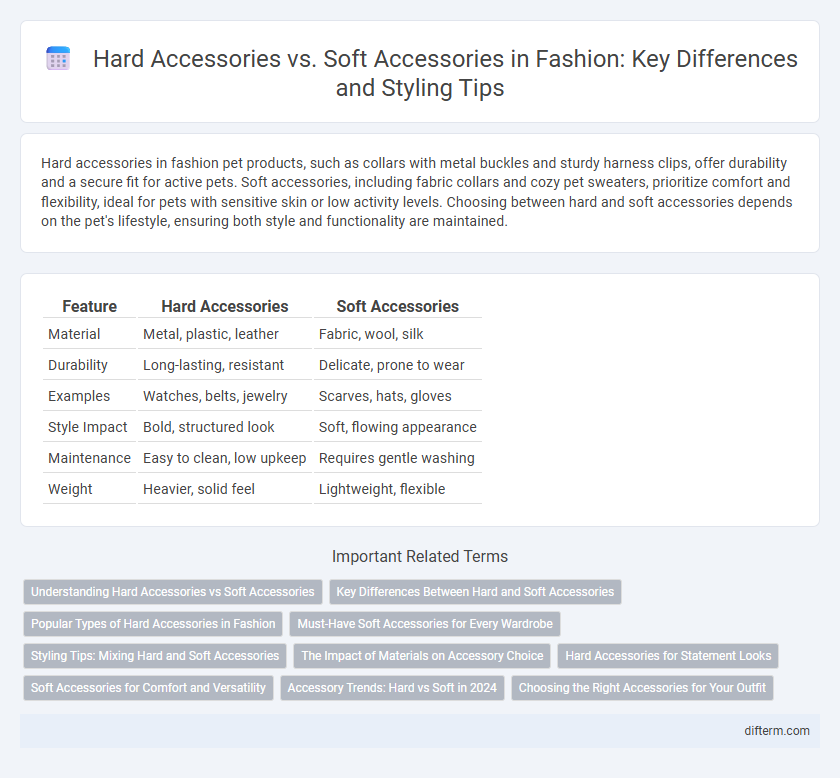Hard accessories in fashion pet products, such as collars with metal buckles and sturdy harness clips, offer durability and a secure fit for active pets. Soft accessories, including fabric collars and cozy pet sweaters, prioritize comfort and flexibility, ideal for pets with sensitive skin or low activity levels. Choosing between hard and soft accessories depends on the pet's lifestyle, ensuring both style and functionality are maintained.
Table of Comparison
| Feature | Hard Accessories | Soft Accessories |
|---|---|---|
| Material | Metal, plastic, leather | Fabric, wool, silk |
| Durability | Long-lasting, resistant | Delicate, prone to wear |
| Examples | Watches, belts, jewelry | Scarves, hats, gloves |
| Style Impact | Bold, structured look | Soft, flowing appearance |
| Maintenance | Easy to clean, low upkeep | Requires gentle washing |
| Weight | Heavier, solid feel | Lightweight, flexible |
Understanding Hard Accessories vs Soft Accessories
Hard accessories, such as belts, watches, and jewelry, provide structure and definition to an outfit, often serving as focal points that enhance the overall style. Soft accessories include scarves, hats, and gloves, offering comfort and texture while complementing the wearer's look through fabric and color coordination. Mastering the balance between hard and soft accessories allows for a versatile and polished fashion statement.
Key Differences Between Hard and Soft Accessories
Hard accessories such as watches, jewelry, and belts provide structure and durability, often crafted from metals, plastics, or leather, making them long-lasting and statement pieces. Soft accessories, including scarves, hats, and gloves, are made from flexible fabrics like cotton, wool, or silk, adding texture, color, and comfort to an outfit. The key difference lies in their material composition and functional role: hard accessories offer rigidity and embellishment, while soft accessories enhance warmth and softness.
Popular Types of Hard Accessories in Fashion
Popular types of hard accessories in fashion include jewelry such as rings, bracelets, necklaces, and earrings crafted from metals like gold, silver, and stainless steel. Watches, eyewear frames, belts with metal buckles, and hairpins also constitute essential hard accessories, offering both functionality and style. These items enhance outfits by adding structure, shine, and a touch of sophistication, distinguishing them from soft accessories like scarves or handbags.
Must-Have Soft Accessories for Every Wardrobe
Must-have soft accessories such as scarves, hats, and gloves add versatility and comfort to any wardrobe while enhancing style with texture and color. Soft accessories crafted from materials like cashmere, silk, and wool provide warmth and elevate outfit aesthetics, making them indispensable for seasonal transitions. These items effortlessly complement hard accessories like belts and watches, creating a balanced and polished fashion ensemble.
Styling Tips: Mixing Hard and Soft Accessories
Balancing hard accessories like metal jewelry, belts, and structured bags with soft accessories such as scarves, fabric bracelets, and delicate hats creates a dynamic contrast that enhances any outfit. Combining chunky metal cuffs with silk scarves or leather belts with knit beanies adds texture and depth, elevating your overall style. For a cohesive look, match the color tones and consider proportion, pairing bold statement pieces with subtle, feminine accents.
The Impact of Materials on Accessory Choice
Material composition significantly influences the choice between hard and soft fashion accessories, with hard accessories often crafted from metals, plastics, or wood to provide durability and structure. Soft accessories typically utilize fabrics like leather, silk, or knitted textiles, offering flexibility and comfort that complement various outfit styles. The tactile qualities and resilience of these materials determine their suitability for different occasions and personal aesthetics.
Hard Accessories for Statement Looks
Hard accessories such as bold metal jewelry, structured belts, and sleek watches create striking statement looks by adding definition and edge to outfits. These accessories enhance fashion ensembles with their rigid shapes and reflective surfaces, providing a contrast to soft fabrics and flowing silhouettes. Incorporating hard accessories boosts confidence and turns simple attire into memorable, standout styles.
Soft Accessories for Comfort and Versatility
Soft accessories such as scarves, hats, and fabric belts provide unmatched comfort and versatility in fashion, adapting easily to various styles and weather conditions. These accessories use materials like cotton, silk, and wool that enhance breathability and softness, making them ideal for all-day wear. Incorporating soft accessories allows for effortless layering and personalization, elevating any outfit with subtle texture and color contrasts.
Accessory Trends: Hard vs Soft in 2024
Hard accessories in 2024 dominate with bold materials such as metal, acrylic, and resin, emphasizing geometric shapes and architectural designs that complement structured fashion silhouettes. Soft accessories trend towards tactile fabrics like velvet, silk, and cashmere, highlighting comfort and fluidity with oversized scarves, headbands, and fabric belts that soften strong outfit statements. This contrast between hard and soft accessories reflects a broader fashion movement prioritizing versatility and personalized stylistic expression.
Choosing the Right Accessories for Your Outfit
Hard accessories, such as belts, watches, and jewelry, add structure and focal points to an outfit, enhancing the overall style with defined shapes and textures. Soft accessories like scarves, hats, and gloves introduce color, warmth, and fluidity, complementing the outfit's fabric and movement. Selecting the right accessories depends on balancing these elements to create a cohesive look that highlights personal style and suits the occasion.
Hard accessories vs soft accessories Infographic

 difterm.com
difterm.com